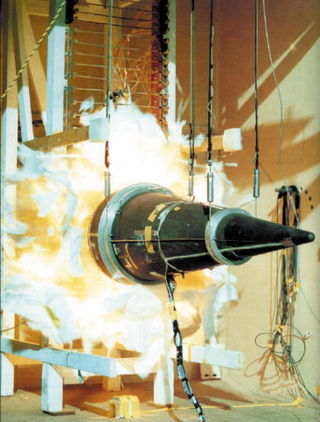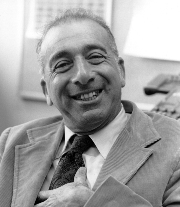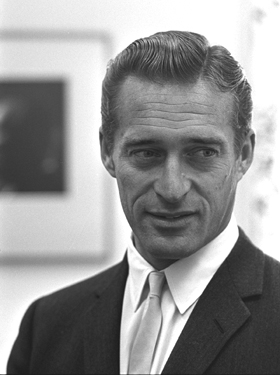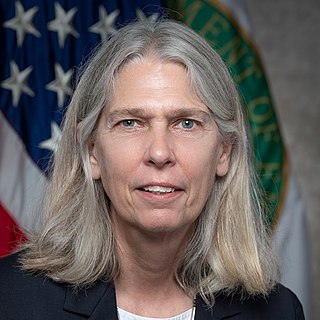Related Research Articles
Lawrence Livermore National Laboratory (LLNL) is a federally funded research and development center in Livermore, California, United States. Originally established in 1952, the laboratory now is sponsored by the United States Department of Energy and administered by Lawrence Livermore National Security, LLC.

Sandia National Laboratories (SNL), also known as Sandia, is one of three research and development laboratories of the United States Department of Energy's National Nuclear Security Administration (NNSA). Headquartered in Kirtland Air Force Base in Albuquerque, New Mexico, it has a second principal facility next to Lawrence Livermore National Laboratory in Livermore, California and a test facility in Waimea, Kauai, Hawaii. Sandia is owned by the U.S. federal government but privately managed and operated by National Technology and Engineering Solutions of Sandia, a wholly owned subsidiary of Honeywell International.

The National Ignition Facility (NIF) is a laser-based inertial confinement fusion (ICF) research device, located at Lawrence Livermore National Laboratory in Livermore, California, United States. NIF's mission is to achieve fusion ignition with high energy gain. It achieved the first instance of scientific breakeven controlled fusion in an experiment on December 5, 2022, with an energy gain factor of 1.5. It supports nuclear weapon maintenance and design by studying the behavior of matter under the conditions found within nuclear explosions.

Stockpile stewardship refers to the United States program of reliability testing and maintenance of its nuclear weapons without the use of nuclear testing.

Sidney David Drell was an American theoretical physicist and arms control expert.

The W84 is an American thermonuclear warhead initially designed for use on the BGM-109G Gryphon Ground Launched Cruise Missile (GLCM).

The W68 warhead was the warhead used on the UGM-73 Poseidon SLBM missile. It was developed in the late 1960s at Lawrence Livermore National Laboratory.

The W86 was an American earth-penetrating nuclear warhead, intended for use on the Pershing II intermediate-range ballistic missile (IRBM). The W86 design was canceled in September 1980 when the Pershing II missile mission shifted from destroying hardened targets to targeting soft targets at greater range. The W85 warhead, which had been developed in parallel with the W86, was used for all production Pershing II missiles.
The W67 was an American thermonuclear warhead developed from June 1966 but then cancelled prior to any production or service use approximately 18 months later.

Siegfried S. Hecker is an American metallurgist and nuclear scientist. He served as Director of the Los Alamos National Laboratory from 1986 to 1997 and is now affiliated with Stanford University, where he is research professor emeritus in the Department of Management Science and Engineering in the School of Engineering, and senior fellow emeritus at the Freeman Spogli Institute for International Studies. During this time, he was also elected a member of the National Academy of Engineering (1988) for outstanding research on plutonium and the forming of materials, and for leadership in developing energy and weapons systems.

Darleane Christian Hoffman is an American nuclear chemist who was among the researchers who confirmed the existence of Seaborgium, element 106. She is a faculty senior scientist in the Nuclear Science Division of Lawrence Berkeley National Laboratory and a professor in the graduate school at UC Berkeley. In acknowledgment of her many achievements, Discover magazine recognized her in 2002 as one of the 50 most important women in science.

Linton Forrestall Brooks is an American government official who served as the Under Secretary of Energy for Nuclear Security from 2002 to 2007.

Berni Julian Alder was a German-born American physicist specialized in statistical mechanics, and a pioneer of computational modelling of matter.

Edward Moses is an American physicist and is the former president of the Giant Magellan Telescope Organization. He is a past principal associate director for the National Ignition Facility & Photon Science Directorate, where he led the California-based NIF, the largest experimental science facility in the US and the world's most energetic laser, that hopes to demonstrate the first feasible example of usable nuclear fusion.

John Stuart Foster Jr. is an American physicist, best known as the fourth director of Lawrence Livermore National Laboratory and as Director, Defense Research and Engineering under four Secretaries of Defense and two Presidents.

Maynard Ansley Holliday is the Assistant Secretary of Defense for Critical Technologies in the Office of the Under Secretary of Defense for Research and Engineering. He previously worked under Barack Obama, during which time he launched the Defense Innovation Unit. Holliday was a Project Manager for Pioneer, a robot that helped to map the inside of the Chernobyl Nuclear Power Plant.
Regina Soufli is a Greek-American physicist and a staff scientist at Lawrence Livermore National Laboratory, in Livermore, California, where she works on the development and the characterization of materials and thin-film coatings for extreme ultraviolet (EUV) and X-ray applications. The results of her work is the heart of the reflective optics used in EUV lithography, the next-generation in semiconductor manufacturing technology, in satellites such as NASA's Solar Dynamics Observatory, or on optics for Free-electron lasers such as the Linac Coherent Light Source at SLAC National Accelerator Laboratory.

Jill M. Hruby is an American mechanical engineer and government official. Since July 26, 2021, Hruby has served as Under Secretary of Energy for Nuclear Security and Administrator of the National Nuclear Security Administration, a post subject to Senate confirmation. Jill Hruby made history as the first woman to ever head a U.S. nuclear weapons lab, serving as director of Sandia National Laboratories from 2015-2017.
Christine Anne Coverdale is an American plasma physicist at Sandia National Laboratories, where she is a Distinguished Member of the Technical Staff.

Andrea "Annie" Kritcher is an American nuclear engineer and physicist who works at the Lawrence Livermore National Laboratory. She was responsible for the development of Hybrid-E, a capsule that enables inertial confinement fusion. She was elected Fellow of the American Physical Society in 2022.
References
- ↑ "Electrochemical characterization of heterogeneous optically selective catalysts | WorldCat.org". www.worldcat.org. Retrieved 2023-02-08.
- 1 2 "National security community honors Miriam John as 2022 Foster Medal recipient | Lawrence Livermore National Laboratory". www.llnl.gov. Retrieved 2023-02-08.
- ↑ Mim John and David Franz - Challenges to Viability of International Agreements on ChemBio Weapons , retrieved 2023-02-08
- ↑ "Miriam John". California Council on Science & Technology (CCST). Retrieved 2023-02-08.
- ↑ "Stop Loose Nukes With Big Data and Crowdsourcing, Experts Urge". Nextgov.com. Retrieved 2023-02-08.
- 1 2 "National Academy of Engineering Elects 106 Members and 18 International Members". NAE Website. Retrieved 2023-02-08.
- ↑ "Recipients of the Eugene G. Fubini Award".